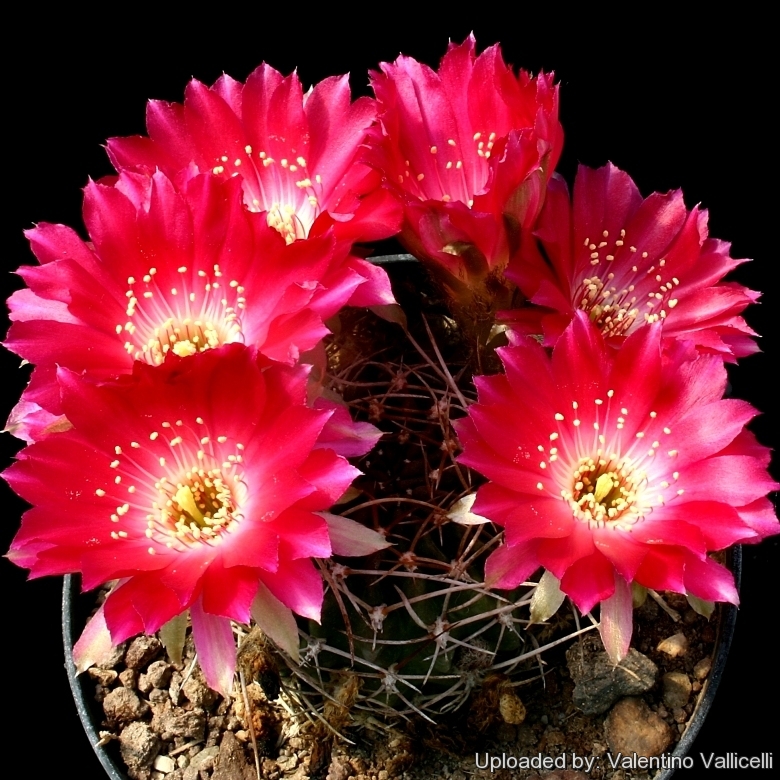
Echinopsis backebergii Photo by: Valentino Vallicelli
R456 (Collector: Walter Rausch) Locality: La Paz, La Paz, Bolivia
Origin and Habitat: South-east La Paz (Bolivia) up to Ayacucho , Cusco and Huancavelica (Peru)
Altitude: 3200-4000 m. above sea level
Habitat: It grows on high altitude in the Peruvian regions of in the Puna widespread vegetation. The climate conditions are dry, with scarce rains. During the dry time, the plant bodies tend to retract and hide into the ground.
Note: The indigenous word "Puna" indicate the western region up to 4500 m that extends from the Peru, going throughout Bolivia to the Argentinian North. Delimited at west by a costal chain of high volcanic picks and by the Cordillera mountainous chain to the east. The Argentinian Puna is the natural continuation of the Bolivian highland.
Synonyms:
See all synonyms of Echinopsis backebergii
back
Accepted name in llifle Database:Echinopsis backebergii Werderm. in Backeb.Neue Kakteen 83, 84, fig. 1931 et: Fedde, Rep. Spec. Nov. 30: 64. 1932Synonymy: 29
Cultivars
(1):
back
Common Names include:
ENGLISH: Carmine Cob
RUSSIAN (Русский): Эxинопсис Бакеберга
SWEDISH (Svenska): Rosensjöborrekaktus
Description: Echinopsis backebergiiSN|9502]]SN|9502]] is a small cactus species, with conspicuous bright coloured blooms. Due to its flower structure typical of the Lobivias it is commonly known as Lobivia backebergiiSN|9503]]SN|9503]]. It is very variable and has received lots of names (like most Lobivias) whit several controversial varieties and subspecies.
Habit: It is a globose perennial stem succulent, that grows individually, but also sprouts abundantly at base, older plants may form mats.
Stem: At first globular becoming cylindrical as it ages, diameter about 4-5(-7) cm. Epidermis pale green to greys-green. The crown is somewhat sunken.
Ribs: 13-19 acute,more or le spiralling, notched, incised above the areoles.
Root: Napiform (Carrot like).
Areoles: Oval with dull white felt at first, 1-1,5 cm distant.
Spines: 1-11 variable, unequal, not always differentiated as centrals and radials
Radial spines: 3-7(-11) short, about 4-50 mm long, thin,curved backward somehow pectinated, at first pale reddish brown, yellow or amber, later greys, sometimes hooked at tip.
Central spines: None or sometime 1 stouter about 1 to 3 cm long, darker with black tip.
Flowers: Large, diurnal, borne laterally near the stem tips, funnel shaped, very colourful pale to dark carmine-red or violet, often with a bluish sheen and white throats, 4-9 cm long, 7,5-9 cm in diameter. Tube relatively slender 4-7 mm in diameter. Tepals lanceolate.
Fruit: About 1,5 cm in long, tannish-green to brownish-red semi-dry splitting vertically or horrizontally.
Seed: Relatively large, black, finely rough.
Subspecies, varieties, forms and cultivars of plants belonging to the Echinopsis backebergii group
 Echinopsis backebergii Werderm. in Backeb.: has 1-11 spines, variable, unequal, about 4-50 mm long and very colourful flowers carmine-red or violet, often with white throats. Distribution: From South-east La Paz (Bolivia) to Huancavelica (Peru).
Echinopsis backebergii Werderm. in Backeb.: has 1-11 spines, variable, unequal, about 4-50 mm long and very colourful flowers carmine-red or violet, often with white throats. Distribution: From South-east La Paz (Bolivia) to Huancavelica (Peru). Echinopsis backebergii subs. wrightiana (Backeb.) M.Lowry: has long thin wispy spines and pale lilac flowers with often lighter throats. Distribution: Huancavelica, Central Peru.
Echinopsis backebergii subs. wrightiana (Backeb.) M.Lowry: has long thin wispy spines and pale lilac flowers with often lighter throats. Distribution: Huancavelica, Central Peru.- Echinopsis boedekeriana Harden
 Echinopsis winteriana (F.Ritter) D.R.Hunt: has large, funnel shaped, fuchsia pink to purple-violet flowers with white centre. Distribution: Huancavelica, Peru.
Echinopsis winteriana (F.Ritter) D.R.Hunt: has large, funnel shaped, fuchsia pink to purple-violet flowers with white centre. Distribution: Huancavelica, Peru. Echinopsis winteriana cv. Fluorescent (F.Ritter) D.R.Hunt: has colourful "shocking fuchsia pink" flowers with a bright white contrasting centre.
Echinopsis winteriana cv. Fluorescent (F.Ritter) D.R.Hunt: has colourful "shocking fuchsia pink" flowers with a bright white contrasting centre. Echinopsis zecheri (Rausch) G.D.Rowley: has harder sharp spines and rather coarser flowers with rich liliac or purple petals and a white throat. Distribution: Ayacucho, Peru.
Echinopsis zecheri (Rausch) G.D.Rowley: has harder sharp spines and rather coarser flowers with rich liliac or purple petals and a white throat. Distribution: Ayacucho, Peru. Lobivia wrightiana f. chilensis hort. ex E.Herzog
Lobivia wrightiana f. chilensis hort. ex E.Herzog
Bibliography: Major references and further lectures:
1) Edward Anderson “The Cactus family” Timber Press, Incorporated, 2001
2) James Cullen, Sabina G. Knees, H. Suzanne Cubey "The European Garden Flora Flowering Plants: A Manual for the Identification of Plants Cultivated in Europe, Both Out-of-Doors and Under Glass" Cambridge University Press, 11/Aug/2011
3) David R Hunt; Nigel P Taylor; Graham Charles; International Cactaceae Systematics Group. "The New Cactus Lexicon" dh books, 2006
4) Willy Cullmann, Erich Götz (Dozent Dr.), Gerhard Gröner "The encyclopedia of cacti" Timber Press, 1984
5) Walter Rausch “Lobivia: The Day Flowering Echinopsidinae from a Geographical Distribution Point of View,” Volumes 1-3 R. Herzig, 1975
6) Hans Hecht “Cacti & succulents” Sterling Pub. Co., 1997
7) Clive Innes, Charles Glass “Cacti” Portland House, 1991
8) John Borg “Cacti: a gardener's handbook for their identification and cultivation” Blandford P., 1970
9) RHS "A-Z encyclopedia of garden plants." United Kingdom: Dorling Kindersley. 2008
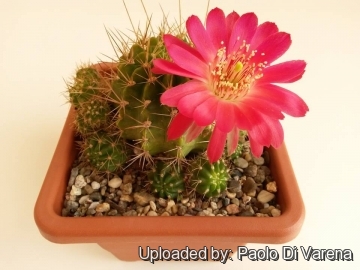 Echinopsis backebergii Photo by: Paolo Di Varena
Echinopsis backebergii Photo by: Paolo Di Varena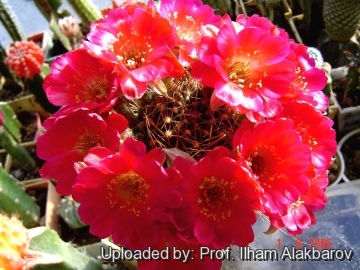 Echinopsis backebergii Photo by: Prof. Ilham Alakbarov
Echinopsis backebergii Photo by: Prof. Ilham Alakbarov Echinopsis backebergii Photo by: Valentino Vallicelli
Echinopsis backebergii Photo by: Valentino Vallicelli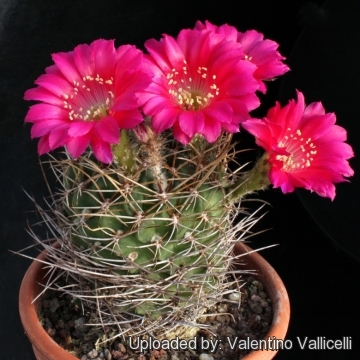 Echinopsis backebergii Photo by: Valentino Vallicelli
Echinopsis backebergii Photo by: Valentino Vallicelli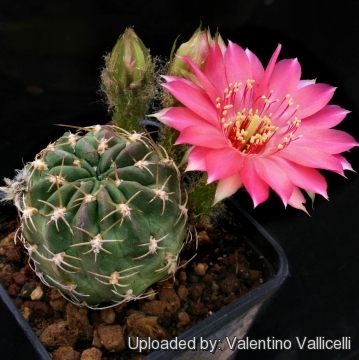 Echinopsis backebergii Photo by: Valentino Vallicelli
Echinopsis backebergii Photo by: Valentino Vallicelli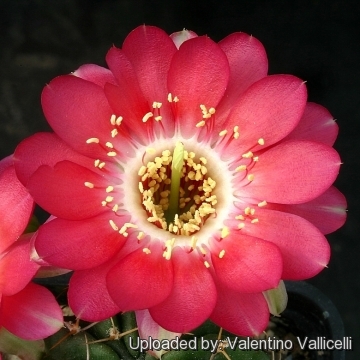 Echinopsis backebergii Photo by: Valentino Vallicelli
Echinopsis backebergii Photo by: Valentino Vallicelli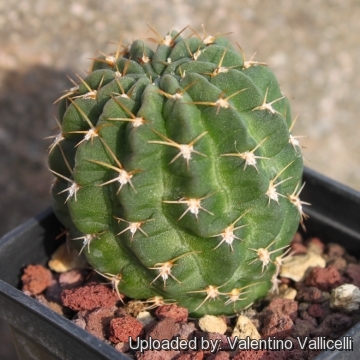 Echinopsis backebergii Photo by: Valentino Vallicelli
Echinopsis backebergii Photo by: Valentino Vallicelli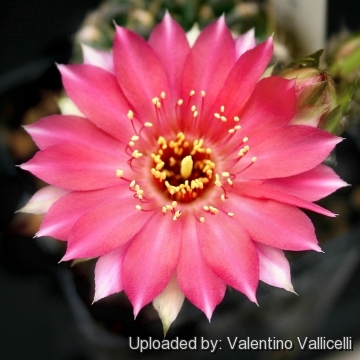 Echinopsis backebergii Photo by: Valentino Vallicelli
Echinopsis backebergii Photo by: Valentino VallicelliCultivation and Propagation: Echinopsis backebergiiSN|9502]]SN|9502]] grows rather slowly and it is sensitive to overwatering (rot prone) and needs a very good drainage to avoid rotting, but requires more moisture than true desert cacti to grow and produce flower. It is a very easy flowerer, if you keep it reasonably cool and absolutely dry during winter and lots of fresh air and sunshine tends to produce better plants and more flowers.
Soil: Use a loose well drained cactus mix.
Repotting: It require a deep pot suited to accommodate the swollen root, repotting with fresh potting-mix should be done every other year or when the plant has outgrown its pot. However, repotting doesn't necessarily mean they'll need larger containers.
Sun Exposure: Light shade when young, full sun later. Outside it likes strong sunshine, but is tolerant and do well with light shade during the hot Summer months. Tends to bronze in strong light, which encourages spine production.
Hardiness: It is cold resistant to -10° ( or even less depending on clones) for short periods of time. It will show its flowers only if we provide an adequate winter rest period.
Watering: Water regularly through the growing season. This can be done weekly or more frequently during the summertime, if the weather is sunny enough, but allow to dry fully before watering again. Kept this way, plants will show a healthy growth. Keep rather dry as soon as the temperature starts dropping in October and keep it dry in winter. The plant survives outside without protection in winter but is then somewhat prone to rot, too.
Fertilization: Give an occasional high potassium liquid feed during the active growing period.
Garden uses: It is a fine plant for a rock garden or container, contrasts well with agaves, yuccas, and low-growing flowering plants.
Pest and diseases: They are generally fairly easy to grow, especially if kept pest-free. They are susceptible to, scale insects and spider mite. Watch carefully for infestations of stem and root mealy bugs, and damage from these may well initiate fungal attack.
Propagation: Seeds, also can be grown from cutting as it branches from the base. Take cuttings spring or summer, let them dry till the ends callous well. Then replant them in fresh cactus soil that is ever so slightly moist, and keep it that way till they root. Surface sowing is the best; seeds germinate in 14-28 days at 20° C , remembering that seedlings dislike strong light and dry conditions.
Your Photos
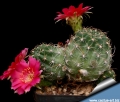
by Cactus Art




















